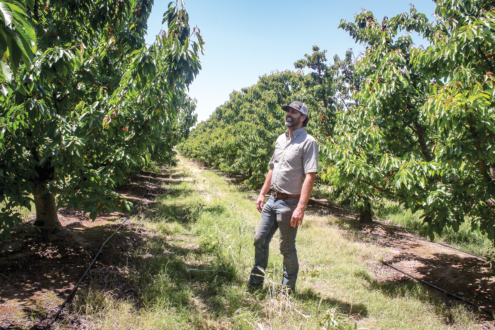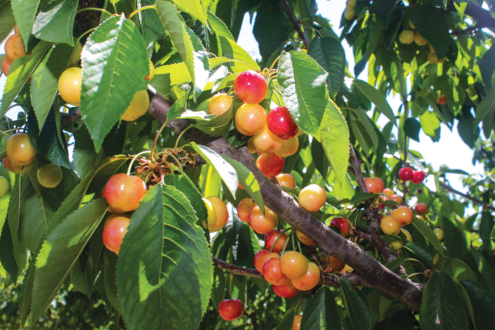May 17, 2023California cherries to miss Memorial Day promo push
As the first one out of the gate, cherries typically kick off the stone-fruit season with peak volumes heading into the Memorial Day holiday.
But longer periods of cool weather this spring have slowed development of the fruit, delaying harvest by about two weeks, farmers say.


Growers in the southern San Joaquin Valley — whose fruit accounted for 34% of the state volume last year — have been picking since earlier this month. Northern California growers, including from the Stockton-Linden-Lodi district and the Gilroy-Hollister-San Jose area, produced 65% of the volume in 2022, according to the California Cherry Board.
James Chinchiolo, who grows cherries in Lodi, said he likely won’t begin harvest until next week, noting that most of his fruit will miss the Memorial Day push.
Some of his cherries are marketed directly to consumers by mail, and he said the lateness of the harvest has some customers “upset that their cherries haven’t shown up yet.”
“I’m like, guys, they’re still ripening on the tree,” he said.
With harvest running behind, Chinchiolo said he may be able to stretch his season into the Fourth of July on later varieties. This would be “super unusual,” he said of the typical three- to four-week harvest. But warming temperatures this week could speed ripening.
For earlier varieties such as Coral, yields have been “right in that sweet spot” of not too heavy and not too light, he said. The trees benefited from the wet year, which provided plenty of winter chilling hours but not damaging frost. A sunny forecast for the start of picking means no rained-on cherries, which are prone to splitting.
Chinchiolo said there is concern that some of his later varieties may not size properly. The fruit is also maturing at different rates on the same tree, meaning he would need to do multiple picks, increasing costs significantly, he said.
Statewide cherry acreage stood at 34,000 in 2022 and 2021, according to the U.S. Department of Agriculture. Since 2012, acreage has fluctuated between 31,000 and 34,000.
Even though Bing cherries from California probably won’t hit grocery stores until June, Tom Gotelli, a San Joaquin County grower, packer and shipper, said “we will have cherries for Memorial Day.”
The “unusually late” cherry season is not isolated to California, he said, noting the Pacific Northwest also is running two weeks behind. This makes for more orderly marketing, as the two region’s crops won’t overlap and flood the market.
“I think it’s a very marketable crop,” Gotelli said. “For the grower, the packer and the sales company, I think it’s a win-win year.”
Early-season cherries typically command a higher price, which levels off as harvest ramps up and more supply hits the market, he added.
In the packinghouse, Gotelli said new sorting machines that can detect fruit size, color and defects have allowed him to reduce his labor by 40% to 50%. The Italian-made fully automated equipment uses optical-sorting technology that’s 97% to 98% accurate, he said.
In Fresno County, grower Lance Jackson said he’s on the verge of harvest and may be able to start picking Coral Champagne and Brooks cherries this week.
“We’re sitting on our hands waiting,” he said. “It’s significantly behind, and we’re seeing that in everything,” from cherries to peaches and nectarines.
After multiple years of drought in which harvest tended to start earlier and earlier, Jackson said he got used to that timing. This year, “we go back to what’s closer to normal,” he said.
He described his production as “maybe 10%, 15% better than last year, but not a record by any means.” Rains earlier this month did not have “detrimental effects” on his cherries, he said.
Though early-season prices have been “crazy” high, Jackson said they’re “never sustainable.”
“It’s always the guys down south that benefit from those big numbers,” he said.
With his season wrapping up this week, Kern County grower Greg Tesch said his focus has been on picking fruit that’s ripe and ready rather than chasing higher prices on early fruit.
The winter and spring deluge has affected the entire produce industry, he said, with delayed planting and crops destroyed by flooding. These weather impacts have left gaps in the produce aisle, with retailers scratching their heads about what to promote from week to week. There’s been a shortage of everything from strawberries to melons, he said, so stores may be looking to cherries to fill more shelves—and paying a hefty price for the supply.
Even though “it’s a natural tendency to try to jump in” when the market is hot, Tesch said delivering unripe fruit to the market “will depress the price through the industry.” The market will reject the fruit if it tastes horrible, he said.
“If (growers) don’t jump the gun, then it’ll be a really good experience for everyone,” he said. “They might receive a slightly lower price, but they’ll get slightly more (fruit) size, and they’ll be appreciated long term.”
— Ching Lee, assistant editor Ag Alert, California Farm Bureau Federation
Photos by Ching Lee















